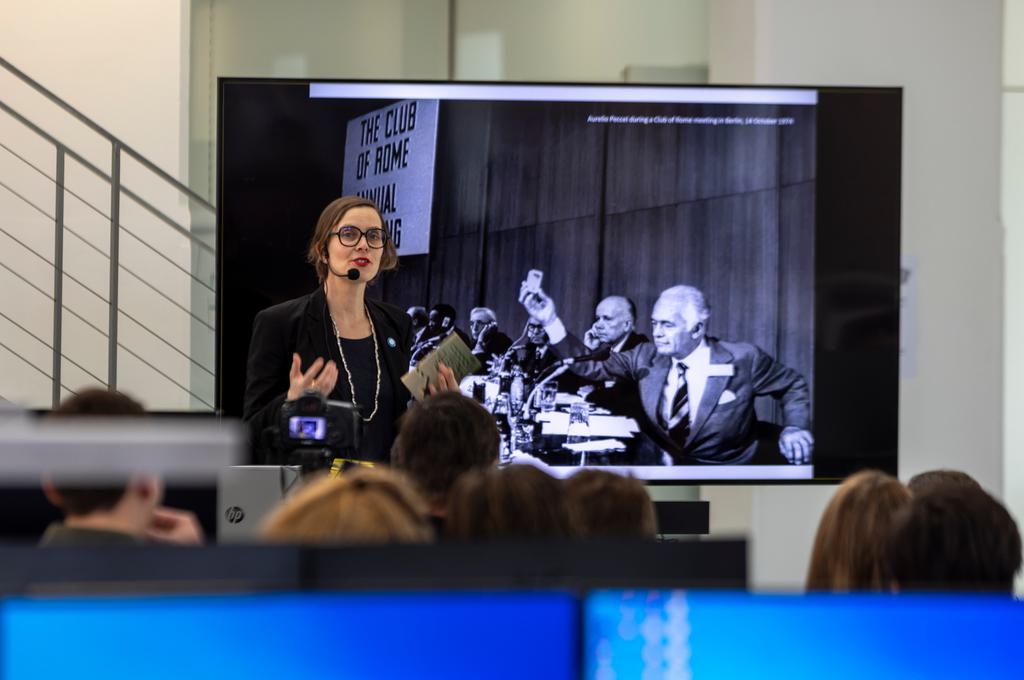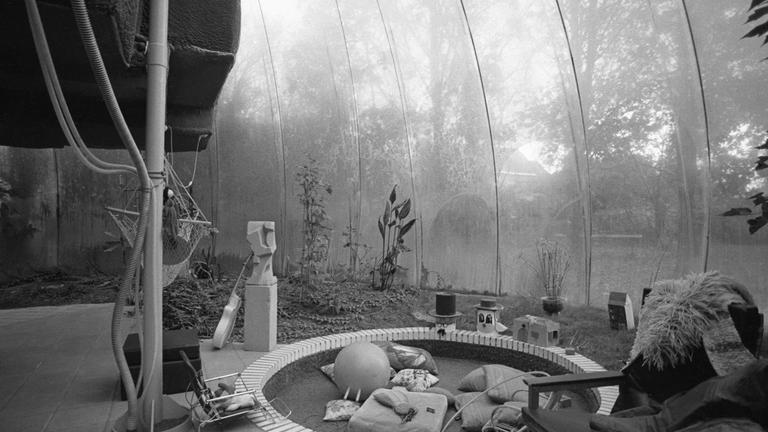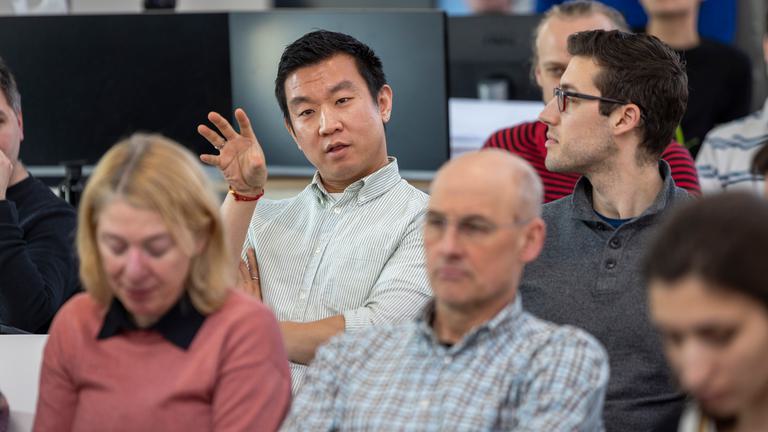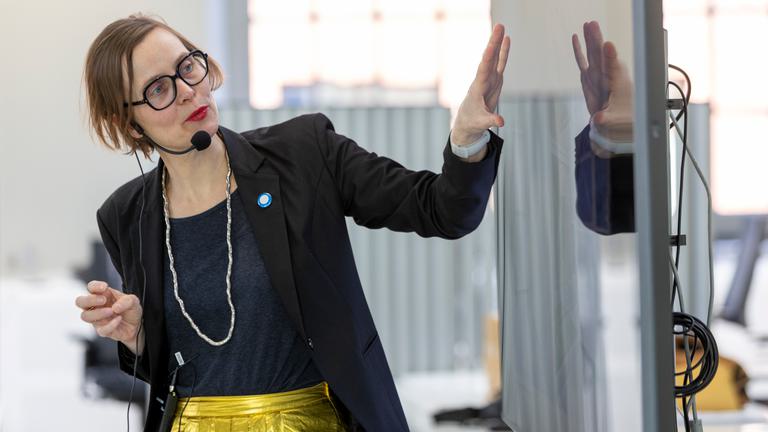In 2024, cepezed celebrates its 50th anniversary. We celebrate this, for one, with a lecture series in which we reflect on (our) architecture. Last Thursday, Véronique Patteeuw linked a number of architectural experiments to the founding of the Club of Rome. We were left with the inspiring feeling that we are heading in the right direction with cepezed.
construct
As an architectural historian, Véronique knows better than anyone that history is a construct. Historical facts are what they are, but if a connection is outlined, it is always something of an afterthought. And coloured. In her lecture 'Architecture In The Age Of Acceleration: Experiments Between High-Tech And Low-Tech' she reflected on architects whose work falls outside the accepted art-historical line. In her case, no 'isms', but experimenting architects and their motives.
blue marble
Motifs related to sustainability took shape around 1970 with the publication of several reports and books, including The Limits to Growth. This reflected a research report by the Club of Rome, on the devastating effects of our use of the earth. At the time, the planet's fragility was made all the more tangible by a novelty: photographs taken from space, of which Blue Marble from 1972 (Apollo 17 mission) is one of the most well-known.
eco science fiction
In comic books and science fiction, the doomsday scenarios outlined caught on enormously. There was even a genre of its own, 'eco science fiction'. The founding of change-oriented action groups like Greenpeace also dates from this era. Unfortunately, things were different for established politics. Although the United Nations invited Aurelio Peccei of the Club of Rome to a congress in 1972, Senator Gaylord Nelson launched Earth Day, and President Jimmy Carter put solar panels on the White House in 1979, his successor Ronald Reagan removed them just as quickly. In 2017, President Donald Trump even envisioned withdrawing from the Paris Agreement, the first global treaty aimed at limiting climate change, which had been signed two years earlier.
parallel history of architecture
Véronique points out that architects are not immediately inclined to consider the long-term consequences of their choices either. Exceptions of course, we at cepezed know this better than anyone else. Véronique notices that many architecture students nowadays opt for activism and do not want to build at all. Given the beautiful, activist architecture of the past, she thinks this is a missed opportunity. All the more important to show those examples: parallel architectural history as a way forward. By anticipating a way of life and making the footprint and weight of a building as small and light as possible, you can really make a difference as an architect.
1948
That parallel history appears to have begun as early as 1948. That year, architect Eleanor Raymond and scientist Maria Telkes designed the Dover Sun House, a house based on Telkes' earlier experiments and heated entirely by sodium sulphate (Glauber's salt). Another example is Drop City, the settlement built from 1960 onwards in southern Colorado. Prompted by the fantastic designs of Richard Buckminster Fuller, a group of enthusiasts designed dome houses made of car panels for Drop City. The 1973 oil crisis gave a major boost to the development of alternative ways of generating energy. By then, Drop City had been abandoned...
véronique patteeuw: devastating conclusions, hopeful designs



buckminster fuller & brand
Buckminster Fuller is best known to cepezed for the legendary question he once asked Norman Foster: 'How much does your building weigh, Mr Foster?' Not for nothing cepezed uses the fictional unit of measurement 'IQ/kg', to indicate that reduction of building material is our priority. Véronique mentioned another 'hero' of our agency: Stewart Brand. Between 1968 and 1971, he published his Whole Earth Catalog, a handbook for building and living in an alternative, do-it-yourself kind of way. Brand's constructive positivism stood out among the many doomsday scenarios.
a balloon home (1973)
Do it yourself-like is also the first of the three examples of experimental design that Véronique concludes her lecture with: A Balloon Home by Lode Janssens. She finds Janssens' design constructively interesting, but mainly because of the 'pedagogical experiment' that this house is at the same time. What does it do to you when you stay in a large space as a family and make intensive contact with the seasons. The garden ran under the balloon screen and when it rained, you would hear it very loudly. The experimentation ended because the snow proved too heavy.
maison serre (1984)
From the French firm Jourda Perraudin, Véronique showed Maison Serre, which is composed of an industrial greenhouse from a catalogue, containing a multifunctional wooden volume. Here, besides sustainability, budget was a motive, as it had already been spent almost entirely on the purchase of the plot. By adding only small interventions in wood to the greenhouse, it has a very small footprint. Moreover, the interior volume could easily be adapted to new wishes of the residents, making it sustainable in this way too.
de fantasie (1984)
Véronique's latest example is a design by Benthem Crouwel Architects for a plot in Almere. This house is a competition entry, with the idea of creating a design free of existing regulations. In this design, we recognised much of our own approach. The house has a demountable steel skeleton and the outer walls consist of sandwich panels. It rests on an ingenious space frame of intersecting steel tubes, which is supported by concrete slabs. The architects later applied the same building principle to a series of customs buildings.
transformation
Just as most good lectures, it offered food for thought. Sustainability is an important motive for innovative experiments, but not the only one. For cepezed, for instance, the 'quality of a building as a product' was important from the start. Are there other motives? What role does aesthetics play and how do you move within the regulations while experimenting? In the final domain, the examples mentioned offered few starting points, because the architects had an extraordinary amount of freedom.
good company
When asked about experiments within the density task, Véronique calls transformation "the task of the future". She thinks that Lacaton & Vassal Architects, among others, handles this in an exemplary manner. cepezed also wholeheartedly endorses the importance of transformation - in any case, Véronique's lecture made it clear that by doing what we do, we are in good company.
Véronique Patteeuw is an architectural historian and a lecturer and researcher at the universities of Leuven and Lausanne. She teaches at the Lille School of Architecture and is editor of architecture magazine OASE. For the 2022 edition, she was one of the four curators of the IABR exhibition It's About Time.


→ Mail bd@cepezed.nl or call our business development team on +31 (0)15 2150000